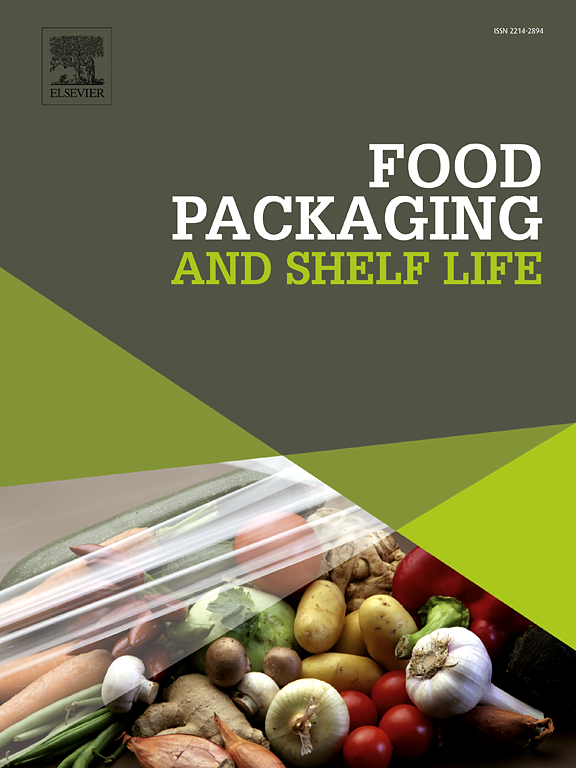Antimicrobial packaging activity enhancement by lemon essential oil pickering emulsion stabilized with nanocellulose microgel particles
IF 8.5
1区 农林科学
Q1 FOOD SCIENCE & TECHNOLOGY
引用次数: 0
Abstract
The incorporation of lemon essential oil (LEO) into cellulose nanofibrils (CNF) shows great promise in the field of sustainable antimicrobial packaging, but is challenged by poor water dispersibility of LEO and the low retention within the film. In this study, nanocellulose microgel (MG) was designed as particle stabilizers for emulsifying LEO and highly stable high internal phase Pickering emulsions (HIPE) were successfully fabricated. MG particles were constructed through chemical bonding of polyethyleneimine onto 2,2,6,6-tetramethylpiperidinyl-1-oxide (TEMPO)-oxidized nanocellulose, characterized with excellent interfacial wetting properties (reduction of oil-water interfacial tension from 11.36 to 7.84 mN/m) and antimicrobial activity (the MIC for Listeria monocytogenes was 125 μL/mL). The HIPE was obtained by dispersing LEO into MG water dispersion (0.5 wt%). The HIPE with LEO fraction as high as 75 % maintained stability within pH 5 to pH 9 without phase separation after 6 days. Films cast from HIPE and CNF blends have excellent integrity and high LEO content (38.94 %). When HIPE was added at 9.6 wt%, LEO was effectively encapsulated by CNF and MG, embedded in the film with high retention, and exhibited significant antibacterial effects against Listeria monocytogenes, antibacterial rate up to 100 %. This work, based on MG, achieves high internal phase emulsification of LEO and enhanced retention within the film, providing a novel perspective and strategy for efficient encapsulation of essential oils and their economical application in antimicrobial packaging.
纳米纤维素微凝胶稳定柠檬精油萃取乳液增强抗菌包装活性
将柠檬精油(LEO)掺入纤维素纳米原纤维(CNF)中,在可持续抗菌包装领域显示出巨大的前景,但受到LEO水分散性差和膜内保留率低的挑战。本研究设计了纳米纤维素微凝胶(MG)作为乳化剂,制备了高稳定性的高内相皮克林乳剂(HIPE)。通过聚乙烯亚胺与2,2,6,6-四甲基哌替啶基-1-氧化物(TEMPO)氧化纳米纤维素的化学键合构建MG颗粒,具有优异的界面润湿性能(油水界面张力从11.36降至7.84 mN/m)和抗菌活性(对单核增生李斯特菌的MIC为125 μL/mL)。通过将LEO分散到MG水分散体(0.5 wt%)中获得HIPE。LEO分数高达75% %的HIPE在pH 5 ~ pH 9范围内保持稳定,6 d后不发生相分离。由HIPE和CNF共混物铸造的薄膜具有良好的完整性和高的LEO含量(38.94 %)。当HIPE添加量为9.6 wt%时,LEO被CNF和MG有效包裹,包埋在膜中,保留率高,对单核增生李斯特菌具有显著的抑菌效果,抑菌率高达100% %。本研究以MG为基础,实现了精油的高内相乳化和膜内滞留,为精油的高效封装及其在抗菌包装中的经济应用提供了新的视角和策略。
本文章由计算机程序翻译,如有差异,请以英文原文为准。
求助全文
约1分钟内获得全文
求助全文
来源期刊

Food Packaging and Shelf Life
Agricultural and Biological Sciences-Food Science
CiteScore
14.00
自引率
8.80%
发文量
214
审稿时长
70 days
期刊介绍:
Food packaging is crucial for preserving food integrity throughout the distribution chain. It safeguards against contamination by physical, chemical, and biological agents, ensuring the safety and quality of processed foods. The evolution of novel food packaging, including modified atmosphere and active packaging, has extended shelf life, enhancing convenience for consumers. Shelf life, the duration a perishable item remains suitable for sale, use, or consumption, is intricately linked with food packaging, emphasizing its role in maintaining product quality and safety.
 求助内容:
求助内容: 应助结果提醒方式:
应助结果提醒方式:


